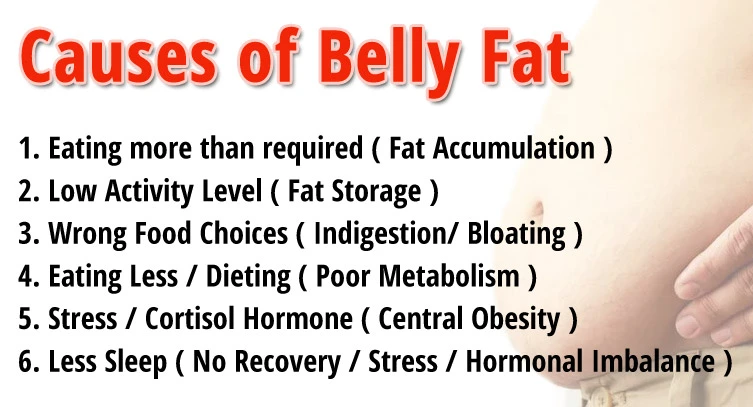Belly fat refers to fat around the abdomen. And abdominal fat is the worst type. There are two types of belly fat- Visceral (fat that surrounds a person’s organs) & Subcutaneous (fat that sits under the skin). Health complications from visceral fat are more harmful than having subcutaneous fat. Stubborn belly fat is a problem, and not just because of how it looks but because it puts you at risk of serious illnesses. Excess belly fat is one of the leading causes of major diseases like-
- heart disease
- heart attacks
- high blood pressure
- stroke
- type 2 diabetes
- asthma
- breast cancer
- colon cancer
If you eat more than your appetite and exercise too little, you’re likely to carry excess weight. But gaining fat solely in your stomach may be the result of specific lifestyle choices. Let’s check out what are those –
ALSO READ- 10 Best Flat Belly Foods: Eat And Burn Belly Fat Fast
Reasons For Stubborn Belly Fat
Sedentary Lifestyle
A sedentary lifestyle has been associated with a direct increase in both visceral and subcutaneous belly fat. Due to sitting for prolonged periods and being devoid of physical movement, fat gets accumulated in the abdominal region. This is because when one does not burn as many calories as they consume, the excess calories get stored in the form of fat in the body.
Try to limit sedentary behaviours and prolonged sitting to get rid of your stubborn belly fat. Aim for at least 150 minutes of moderate to vigorous physical activity each week. In case sitting is part of your work, try to incorporate “standing breaks” every 30–90 minutes by standing for 5–10 minutes or taking a quick walk around your surroundings.
ALSO READ- 5 Fat Burning Exercises That You Can Do At Home
Poor/ Slouching Posture
Maintaining the right posture is essential for your body to function properly. Individuals with poor body posture typically have some unusual-looking fat distribution. When you have a weak posture, this can cause an anterior pelvic tilt, where your pelvis tilts forward. And this makes your lower back arch more pronounced, your bum sticks out and your stomach protrudes, which creates the illusion of a larger stomach.
Therefore, if you are trying to get rid of your lower belly pooch, try to maintain a good posture as much as possible. Always try to simply sit and stand up straight. This is because if you sit upright your belly will not fold in on itself as much and this will create an illusion of a trimmer middle.
ALSO READ- 5 Bed Exercises For Flat Belly!!
Bad Eating Habits
Studies have shown that poor dietary habits are the leading cause of obesity and stubborn belly fat. Many people consume more added sugar daily than they realize in the form of junk foods, fried foods, and preserved foods. We should avoid all these as they are rich in synthetic additives, artificial flavouring and excessive amounts of sugars. They not only cause the prevalence of a higher level of belly fat but also lead to many health-related problems like heart diseases, type 2 diabetes, high blood pressure, high cholesterol and many more.
Foods high in added sugar include baked goods, pastries, muffins, flavoured yoghurts, breakfast cereals, granola and protein bars, and prepackaged foods. Not only these but a large intake of calories and sugar in the form of sugar-sweetened beverages with little to no nutritional value also leads to abdominal fat.
While all foods and drinks can be enjoyed in moderation, it’s best to limit them to special occasions. Also, try to increase your protein intake as it is associated with lower abdominal fat and moderate body weight.
ALSO READ- Top 12 Protein Rich Food Sources For Vegetarians

The Poor Gut Bacteria
Trillions of bacteria live in our body, the majority of these are located in our intestines. Some of these bacteria benefit health, while others can cause problems. People’s gut bacteria play an important role in regulating metabolites that affect fat storage around the waist. That is why an unhealthy balance of gut bacteria promotes weight gain, including abdominal fat.
Consuming a low-fibre diet which is high in sugar and saturated fat tends to be linked to unhealthy gut bacteria. On the other hand, a fibre-dense diet rich in fruits and vegetables and whole, minimally processed foods seems to create a healthy gut. So, always choose wisely as healthy gut bacteria are very important for maintaining a flat belly.
ALSO READ- 10 Probiotic Foods To Improve Digestion & Boost Immunity
Chronic Sleep Deprived
An adequate amount of sleep is crucial for our health as our bodies need sufficient time to burn up the excess energy and restore themselves every day.
Sleeplessness and irregular sleep cycles lead to excess cravings, and untimely uncontrolled eating that the body believes will help in covering for the lack of sleep-related energy. Therefore, unhealthy eating behaviours called emotional eating may play a part in the development of abdominal fat.
Normally, fat due to increased calorie consumption is preferentially deposited subcutaneously or under the skin. But the inadequate sleep appears to redirect unhealthy fat to the more dangerous visceral compartment. Time management can help a lot in this regard.
ALSO READ- Absolute And Quickest Ways to Reduce Belly Bloating
Mindless Alcohol Consumption
One of the many vices of excessive drinking is increased belly fat. Studies show that individuals with drinking habits have more visceral fats and adipose (fatty) cells in the belly region than those who avoid the same. Let’s find out how alcohol contributes to belly fat and overall weight gain-
- Alcohol contains many calories.
- Several alcoholic beverages are high in sugar.
- Drinking alcohol may increase appetite, leading to greater overall calorie intake. It may also lead to poorer judgement, resulting in greater consumption of less nutritious foods.
- Alcohol consumption may increase cortisol, which promotes abdominal fat storage.
- It may alter hormones related to hunger and fullness.
ALSO READ- Cure A Hangover: before you drink; while you drink; and the morning after
Stress
When a person undergoes a stressful situation, the body produces a steroid hormone known as cortisol to help one cope with the stress. Prolonged release of this hormone can slow down the metabolism. Under stress, people often reach for high-calorie food for comfort. This can lead to overconsumption of foods high in fat and sugar. Excess calories consumed and a slow metabolism lead to fats accumulating in our bodies, especially around our bellies.
Chronic stress can lead to the accumulation of abdominal fat and make it hard to lose as it can increase the production of cortisol in excess. Also, chronic stress can affect other lifestyle behaviours that may lead to weight gain, like poor sleep quality, sedentary behaviours, and physical inactivity. Therefore one should practice healthy lifestyle behaviours to manage chronic stress and control stubborn belly fat.
ALSO READ- 10 Best Healthy Weight Loss Drinks To Lose Fat Fast
Menopause
An expanding waistline is sometimes considered the price of getting older — even if you aren’t gaining weight. For women, this can be especially true after menopause. In postmenopausal women, belly fat accounts for 15 to 20% of their total body weight, compared with 5 to 8% in premenopausal women.
This is likely due to a decreasing level of estrogen, which appears to influence the fat to be stored around the waist rather than on the hips and thighs. Not only the hormonal changes but muscle mass typically diminishes with age, while fat increases. Losing muscle mass slows down the metabolism as well. This can make it more challenging to lose stubborn belly fat. Menopause weight gain isn’t inevitable, however. One can reverse it by following healthy-eating habits and leading an active lifestyle.
ALSO READ- Weight Reducing Yoga- 5 Breathing Exercises For Weight Loss
Genetics
The tendency to gain or carry weight around the waist and have an “apple” rather than a “pear” shaped body — might have a genetic component as well. Our genes could be linked to a variety of factors, from our cravings to our lagging metabolism to the fat accumulated on our belly. A person with an inherently slow metabolic rate is thus more likely to develop a bigger belly.
It’s all about susceptibility! Genes can increase a person’s susceptibility to developing fat around the waist, but individuals can take action to reduce their risk. That means you may have the genes for developing stubborn belly fat, but having a fat belly doesn’t have to be your fate if you continue to eat well and exercise.
